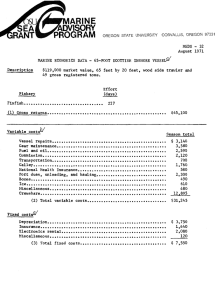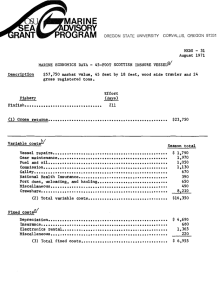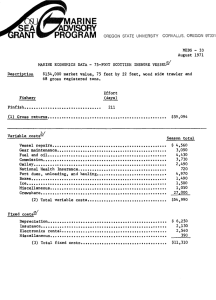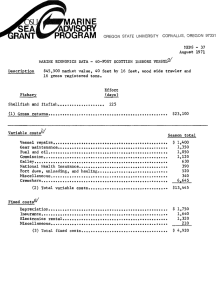Guidelines for Grid Connection of Marine Energy Conversion
advertisement
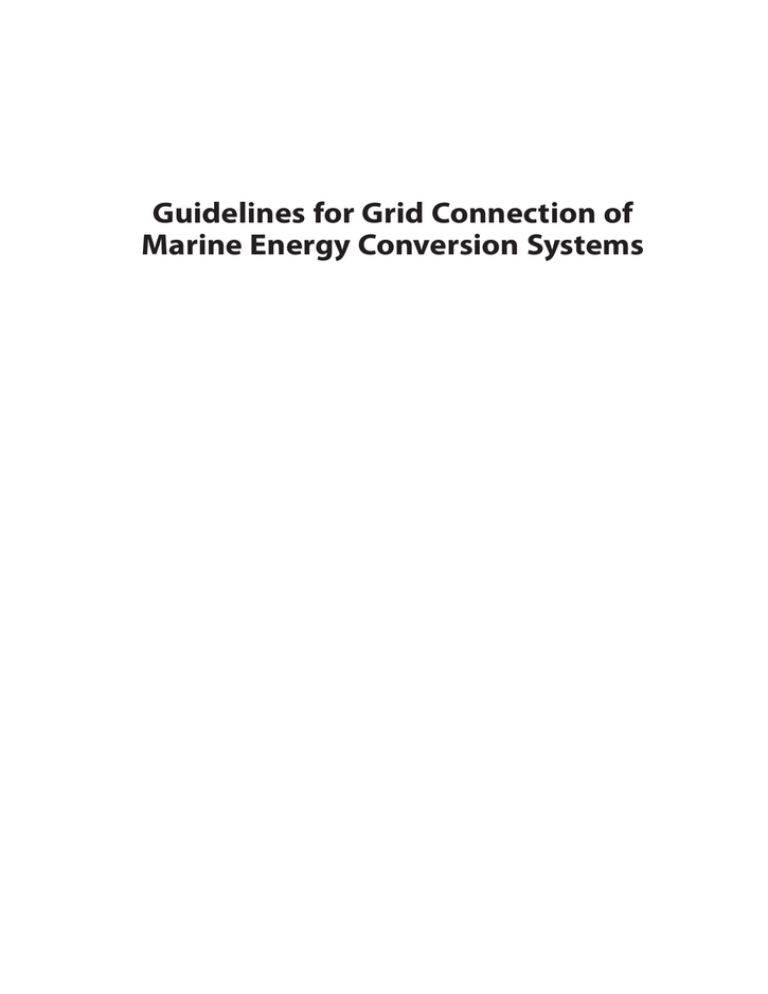
Guidelines for Grid Connection of Marine Energy Conversion Systems Foreword This document has been prepared in consultation with The European Marine Energy Centre Ltd (EMEC) and with other interested parties in the UK marine energy community. It is one of eleven publications in the Marine Renewable Energy Guides series, included in the following figure. Certification Guide Assurance Device development Manufacture and Testing Tidal Tank Test Wave Tank Test Tidal Performance Testing Wave Performance Testing Heath and Safety Guide (BWEA) Design Basis (including install, mooring and foundations) Reliability and Maintainability Project Development Tidal Resource Assessment Wave Resource Assessment Scheme development Grid Connection Site Definition/Selection Device Performance Figure 1 — Marine Renewable Energy Guides Acknowledgements This document was written by Lyndon Greedy, Garrad Hassan and Partners Limited, under contract from the European Marine Energy Centre Ltd (EMEC). Guidelines for Grid Connection of Marine Energy Conversion Systems Marine Renewable Energy Guides First published in the UK in 2009 by BSI, 389 Chiswick High Road, London W4 4AL © The European Marine Energy Centre Ltd 2009 The information contained in this document is for guidance only and it is not intended, and should not be used, as a substitute for taking technical advice in any specific situation. Whilst every effort has been made to provide accurate information on these pages, neither the European Marine Energy Centre (EMEC), nor any of its employees, make any warranty, expressed or implied, or assume any liability (to the extent permitted by law) or responsibility for the accuracy or completeness of any information contained in this document. In no event shall EMEC be liable (to the extent permitted by law) for any special, incidental, indirect or consequential damages or any damages whatsoever, whether in an action for misrepresentation or of contract, negligence or other delictual action, arising out of or in connection with, the use of the information available in this document or for omissions or the continued accuracy of this document. The right of Lyndon Greedy to be identified as the author of this Work has been asserted by him in accordance with sections 77 and 78 of the Copyright, Designs and Patents Act 1988. EMEC has no responsibility for the persistence or accuracy of URLs for external or third-party internet websites referred to in this book, and does not guarantee that any content on such websites is, or will remain, accurate or appropriate. Typeset in Great Britain by Monolith – www.monolith.uk.com Printed in Great Britain by The Charlesworth Group, Wakefield British Library Cataloguing in Publication Data A catalogue record for this book is available from the British Library ISBN 978-0-580-65030-7 Contents Introduction 1 1 Scope 2 2 Normative references 2 3 Terms and definitions 3 4 Electrical parameters 4 4.1 General 4 4.2 Frequency 5 4.3 Voltage range 5 4.4 Power factor and voltage control 6 4.5 Power quality 8 5 Protection 10 5.1 General 10 5.2 Protection at the point of connection 10 5.3 Electrical infrastructure protection 10 6 Electrical islanding 12 7 Earthing 13 7.1 General 13 7.2 Electrical infrastructure onshore 13 7.3 Electrical infrastructure offshore 13 7.4 Marine generators 14 8 Electromagnetic compatibility 14 9 Commissioning and Information 14 9.1 Commissioning 14 9.2 Information 14 10 Operation Bibliography 15 16 v Guidelines for Grid Connection of Marine Energy Conversion Systems Introduction This document represents good practice guidelines for the grid interfacing of a Marine Generation Installation (MGI) located in Great Britain and provides guidance and references to applicable documentation. Attention is drawn to the following documents: • The Health and Safety at Work Act (1974); • The Electricity Safety, Quality and Continuity Regulations (2006) and any subsequent amendments; • The Distribution Code (2008); • The Electricity Act (1989). Within this document are a range of requirements given so that an appropriate electrical system design can be established whilst not causing adverse network conditions and unnecessary deterioration in existing network conditions. In general, the connection voltage is determined by the installed capacity of the installation and the proximity of the local area network. Multiple connections may enable connections to relatively lower voltage networks. The developer is advised to contact and meet with the host network operator to discuss the marine generation scheme and the connection arrangement at the earliest opportunity. A number of regulations, codes and recommendations exist which are applicable to the connection of generation schemes. These are relevant to this document and are listed in Clause 2. This document provides general information and guidance on the matters specifically applicable to the network interfacing of marine generation schemes. This document does not take precedence over existing codes, recommendations and standards. 1 Marine Renewable Energy Guides To aid the reader, where possible each section of this document is structured as follows: 1. Introduction to the subject. 2. Reference to the appropriate obligations as a generator. 3. Outline of how the designer should go about satisfying the statutory requirements. 1 Scope This document provides guidance to those developing a MGI for connection to electricity distribution networks at voltages below 132 kV. It is applicable to and provides guidance for marine energy generation developers with MGIs subject to the requirements of the Distribution Code. The geographical area of application of this document is Great Britain only. This document does not cover the design of substations or the specification of equipment. It is intended to provide the designer of the electrical infrastructure for MGIs, with a comprehensive scope of requirements to achieve a satisfactory interface with the local electricity network. This document is not applicable to MGIs that are subject to the Grid Code. NOTE At the time of writing, the connection requirements applicable to offshore wind energy projects subject to the Grid Code are in an early stage of development. A number of options and standards are emerging as to the design, ownership and operation of the offshore assets and the location where these conditions apply. Following the establishment and consolidation of such requirements and larger-scale development of marine energy, their transfer to marine generation is expected to be straightforward. 2 Normative references The following referenced documents are indispensable for the application of this document. For dated references, only the edition cited applies. For undated references, the latest edition of the referenced document (including any amendments) applies. Notes of guidance for the protection of embedded generating plant up to 5 MW for operation in parallel with Public electricity suppliers’ distribution systems, Engineering Technical Report No. 133. Revision 1, 1995 Planning levels for harmonic voltage distortion and the connection of non-linear equipment to transmission systems and distribution networks in the United Kingdom, Engineering Recommendation G5/4-1, Issue 1, 2005 Planning limits for voltage fluctuations caused by industrial, commercial and domestic equipment in the United Kingdom, Engineering Recommendation P28, Issue 1, 1989 Planning limits for voltage unbalance in the UK for 132 kV and below, Engineering Recommendation P29, Issue 1, 1990 2 Guidelines for Grid Connection of Marine Energy Conversion Systems Recommendations for the connection of embedded generating plant to public distribution systems above 20 kV or with outputs over 5 MW, Engineering Recommendation G75/1, Issue 2, 2002 Recommendations for the connection of embedded generating plant to the public electricity suppliers distribution systems, Engineering Recommendation G59/1, Issue 1, 1991 Statutory Instrument 2002 No. 2665, The electricity safety, quality and continuity regulations, 2002 Statutory Instrument 2006 No. 1521, The electricity safety, quality and continuity (amendment) regulations, 2006 The distribution code and the guide to the distribution code of licensed distribution network operators of Great Britain, Issue 9 – June 2008 3 Terms and definitions For the purposes of this document, the following terms and definitions apply. 3.1 marine generator (MG) component that derives its power source from the marine environment NOTE A number of MGs installed form a collection of MGs, which could be referred to as an array or, a wave farm. 3.2 marine generation installation (MGI) all main and supporting electrical and non-electrical equipment up to the point of supply or the point of connection, that facilitate the operation of a single or a collection of MGs 3.3 network electricity network to which the marine generation installation may be connected NOTE The network enables electrical connection of the marine generation installation and the export and import of electricity. 3.4 network operator agent who holds a distribution licence and is responsible for making technical agreements with customers seeking connection to the distribution network 3.5 point of connection point on the network, which determines the connection of the MGI assets to the network operator’s assets NOTE Normally this point is where the network operator requires the generator to conform to the requirements defined by the network operator and/or as specified in applicable regulations, codes and recommendations. 3 Marine Renewable Energy Guides 3.6 point of supply point on the network or within the MGI where the energy is monitored or metered 3.7 point of common coupling point on the network, electrically nearest the MGI at which other users are or are not connected 3.8 electrical infrastructure complete electrical installation of the MGI necessary to facilitate the connection of the MG(s) to the network 3.9 owner proprietor of the MGI NOTE For the purposes of this document, the term ‘owner’ includes any person acting under the authority of the owner and may include the developer, engineer, consultant, designer, contractor and operator. 3.10 power factor ratio of the real power (W) to the apparent power (VA) 4 Electrical parameters 4.1 General Following the connection of a MGI to the network, the electrical conditions at the point of connection shall remain within specified limits and not cause unsatisfactory conditions at any location on the network and to other users of the network. To satisfactorily interface with the network, the electrical infrastructure shall be designed and constructed and the MGI shall be operated to comply with the conditions detailed or referenced in this document. In addition to this document, the Distribution Planning and Connection Code (DPC) section of the latest issue of The Distribution Code and The Guide to the Distribution Code of Licensed Distribution Network Operators of Great Britain shall be followed. It is advisable that the owner of the MGI liaises with the network operator to establish mutual agreement on the method and terms of connection. That part of this process should include a meeting with the distribution network operator (DNO) to discuss the MGI, the network connection and the general and specific requirements of the network operator. 4 Guidelines for Grid Connection of Marine Energy Conversion Systems In undertaking the electrical design and construction of the MGI, the specifications of the network operator shall be met as well as the methods of design, construction and operation of the MGI. 4.2 Frequency 4.2.1 Normal operation In accordance with section 27 –(3)(a) of The Electricity Safety, Quality and Continuity Regulations, 2002 (ESQCR) the nominal frequency at the point of connection shall be 50 Hz ± 1 %. In accordance with section DPC 7.4.1 of the Distribution Code, the generator shall supply its registered capacity under normal conditions within a frequency range of 49,5 Hz to 50,5 Hz. In establishing the electrical infrastructure design and in carrying out the construction, it shall be assumed that: • the nominal frequency is 50 Hz; • under normal operating conditions the frequency may vary by 1 %, above or below 50 Hz; • the registered capacity of the MGI(s) continuously operates between 49,5 to 50,5 Hz. 4.2.2 Exceptional conditions At times due to the dynamic nature of network loads and other power generation installations, the frequency can deviate in excess of the limits defined in 4.2.1 for short periods of time. Under exceptional conditions the frequency may vary between 47 Hz and 52 Hz. The required duration of continued operation at frequencies above 50,5 Hz or below 49,5 Hz is a specification that can be agreed with the network operator. Typical values stated in Engineering Recommendation (ER) G59/1 are 0,5 seconds for -6 % and +1 % of nominal frequency. NOTE It is noted that although the ESQCR and Distribution Code state this frequency range, ER G59/1 recommends generation protection, frequency settings of 47 Hz and 50,5 Hz 4.3 Voltage range The voltage range at the point of connection could vary by a specified amount above or below the nominally declared voltage. 5 Marine Renewable Energy Guides In accordance with section 27 –(3)(c) of The Electricity Safety, Quality and Continuity Regulations, 2002 and assuming the connection voltage is less than 132 kV, the variation in voltage at the point of connection may be 6 % above or below the nominally declared voltage. The electrical infrastructure shall be designed and constructed to enable operation over this entire range. 4.4 Power factor and voltage control 4.4.1 General It is an important issue in operating distribution networks that the power factor at the point of connection is operated to ensure reactive power flows and that voltage levels are maintained within certain limits. Although the requirements of the network operator may vary depending upon the location and installed capacity of a project, some general guidance information on power factor and voltage control is provided in 4.4.2 to 4.4.5. 4.4.2 Power factor improvement Unless otherwise stated by the network operator, the basic requirement of the MGI shall be to operate at or as close as possible, to unity power factor at maximum output. The installation shall be designed and constructed to achieve a power factor of as close to unity as possible; for example, in its simplest form this may be the design and installation of power factor correction capacitors (in the case of an inductive installation). 4.4.3 Power factor control mode An enhanced form of power factor improvement is power factor control mode. In this mode of operation, the MGI is required to achieve a specified power factor at all times. The import or export of reactive power, with respect to the MGI, as the real power output of the MG(s) changes (in accordance with the changing marine energy resource) should be considered. The network operator may require the MGI to be operated either: • within a certain power factor range (e.g. 0,98 inductive to unity) or • at a specified power factor (e.g. Unity) at the point of connection and throughout the operating range. 6 Guidelines for Grid Connection of Marine Energy Conversion Systems A maximum limit on the level of reactive power import and export is something that would need to be agreed between the owner and the network operator. It is acknowledged that power factor mode could be onerous, particularly for smaller MGIs; therefore, if operating the MGI at a fixed power factor will be difficult to achieve and if it is: • of a relatively low (e.g. ~2 MW) installed capacity, and • does not bring about adverse network conditions, it would be advisable to negotiate an acceptable power factor range with the network operator. NOTE In the absence of any guidance, the owner is advised to assume that the default power factor at the point of connection is unity. The network operator may have a requirement for the MGI to either import or export a specified level of reactive power. 4.4.4 Voltage control mode The network operator may require the MGI to control the voltage at the point of connection. The MGI shall be designed, constructed and operated to monitor the voltage at the point of connection and to adjust its reactive power consumption to regulate the voltage at the point of connection to a value or within a range as specified by the network operator. In carrying out the design and construction work, the MGI shall not adversely affect any existing voltage control equipment operated by the network operator. 4.4.5 Power factor control mode or voltage control mode Under some network conditions the network operator may need some customers to operate their installations in either power factor control mode or voltage control mode. If the network operator requires this level of service, the MGI shall be subject to two modes of operation: • Power factor control mode (see 4.4.3); • Voltage control mode (see 4.4.4). Under normal operating conditions, the MGI shall operate in power factor control mode. The MGI shall be designed, constructed and operated to regulate a power factor value or within a power factor range as specified by the network operator. For this mode of operation it is a precondition that the voltage at the point of connection is within a range specified by the network operator. 7 Marine Renewable Energy Guides Under voltage control conditions, the mode of operation shall be voltage control mode. Voltage control mode shall commence when: • the voltage at the point of connection exceeds limits as specified by the network operator; or • the MGI is instructed to do so by the network operator. To operate in voltage control mode, the MGI shall be designed, constructed and operated to adjust its reactive power consumption to regulate the voltage at the point of connection in accordance with the requirements of the network operator. 4.5 Power quality 4.5.1 General Guidance on power quality issues for the MGI, such as voltage steps, voltage flicker and harmonics emissions, can be obtained from a wind turbine standard in this area (see BS EN 61400-21:2002). 4.5.2 Voltage fluctuations The switching on/off of electrical equipment can cause disturbances in network voltages. This in turn, if excessive, can cause a perceptible flickering of lights of other network users. This can be a nuisance to the users of the network and result in complaints to the network operator. In accordance with section DPC 4.2.3 (a) of the Distribution Code, the voltage fluctuations at the point of connection shall conform to the limits defined in ER P28, Issue 1. To conform to the requirements defined in ER P28, the impact of the operation of the MGI on the network voltage shall be considered in the electrical design and construction works. This shall include consideration of: • flicker introduced to the electrical system as a result of the continuous operation of the MG(s); • switching on/off as part of the routine operation of the installation (e.g. switching on/ off individual generators with consequential inrush currents); and • occasional switching on/off of equipment (e.g. first and later energization(s) of the MGI, particularly transformers). Calculations in respect of each item detailed above shall be made to confirm compliance with ER P28. Upon request, these calculations can be submitted to the network operator. 8 Guidelines for Grid Connection of Marine Energy Conversion Systems At the present time, there has been little standardization of flicker calculation methodology for MGs. For guidance purposes only, BS EN 61400-21:2002 can be consulted. NOTE These items are likely to be part of the normal operation of the MGI. The owner would have knowledge of the normal running regime of the MGs, how the output power ramps up/down, how individual generators are switched in/out and how the entire installation is switched in/out. With this information the impact upon the voltage at the point of connection can be assessed. 4.5.3 Harmonics emissions At the point of connection the network voltage may be subject to harmonic distortion due to the presence of one or more harmonic multiples of the fundamental frequency. This can be due to the presence of power electronics conversion systems. Although all issues of harmonics in the electrical system designs should be addressed, the impact is likely to be more significant for installations comprising machines with power electronics equipment as part of the power conversion process. In accordance with section DPC 4.2.3 (b) of the Distribution Code, the harmonic content at the point of connection shall comply with the limits defined in the latest issue of ER G5/4-1. The connection of the MGI shall not increase harmonic levels above the limits as specified in ER G5/4-1. In establishing the electrical system design, the harmonics emissions from the installation shall be taken into account and the combined effect of the following shall be within the limits defined in ER G5/4-1: • existing harmonics from the grid at the point of connection; • harmonics emissions from the generation installation as monitored at the point of connection. Calculations in respect of these items shall be made to determine the harmonic emission levels at the point of connection as a result of the connection of the MGI with the network to determine compliance with ER G5/4-1. It may be necessary for the network operator to conduct measurements to determine the existing levels of harmonic distortion. At the request of the network operator, these calculations shall be made available. 4.5.4 Voltage unbalance The phase voltages at the point of connection should be evenly balanced although it is possible that some imbalance may exist. In accordance with section DPC 4.2.3 of the Distribution Code, the voltage unbalance of the MGI shall conform to the requirements defined in the latest issue of ER P29. 9 Marine Renewable Energy Guides In establishing and constructing the electrical infrastructure, the interaction of the MGI on the voltage balance at the point of connection should be considered and the limits of voltage imbalance shall not be exceeded. NOTE The issue of unbalance normally comes about through an uneven distribution of single phase loads. The MG(s) is expected to be a three phase unit with even phase balancing. This clause is not expected to be a significant issue for the MGI, although any unbalance introduced by the MGI is to be minimized. 5 Protection 5.1 General Electrical protection devices are needed in order to: • protect the MGs from electrical faults and overloads within the devices, and from the effect of disturbances caused by the electrical infrastructure or the network; • protect the electrical infrastructure from internal faults, and from faults within the MGs; • protect the network from disturbances caused by the MGs, and from faults within the electrical infrastructure. 5.2 Protection at the point of connection The requirements of the network operator are set out in the connection offer and/or connection agreement, and are likely to refer to ERs G59, G75, and ETR 113. These requirements will define the protection devices applicable at the point of connection. 5.3 Electrical infrastructure protection 5.3.1 General As there is necessary interaction of issues in the protection design, this clause relating to the customer’s installation is included as further guidance information on protection. Standard electrical engineering design practice and protective relays are likely to be sufficient to protect the electrical infrastructure and the MGs; for guidance, see BS EN 60255. 10 Guidelines for Grid Connection of Marine Energy Conversion Systems The optimum solution is likely to depend on the device type and on project-specific factors, and so is not detailed here. Important issues which may differ from standard practice are listed in 5.3.2 to 5.3.8. 5.3.2 Circuit breakers or fuses As marine generators could be difficult to access, the use of circuit breakers instead of fuses should be considered, as these can be remotely reset. Fuses may still be justified if it can be shown that the probability of operation is acceptably low. The MGI may comprise relatively long cabling systems. Switching of longer cables can be a significant design issue because of the high capacitive currents and transient over‑voltages. In this respect it is advisable to consider in their designs the switching duty of switchgear. 5.3.3 Discrimination It may be acceptable to have a lower level of discrimination than standard industrial practice. This implies that an electrical fault could result in the disconnection of more than just the faulty device or component. This could be justified if it allowed the protective device to be placed in a more accessible position (i.e. onshore, or on an offshore substation structure, rather than on the seabed). 5.3.4 Location of protective devices As noted in 5.3.3, there are advantages in locating protective devices onshore or on an offshore substation structure. Alternatively, there are advantages in having a standard protective arrangement included in each MG. This will avoid project-specific design and installation of protection equipment. The resolution of this conflict may be different for different protective functions; for example, protection against high or low frequency can be provided by a single protective relay onshore, whereas protection against high or low voltages may best be achieved within each MG. 5.3.5 Voltage range It may be necessary to specify protective devices that can continue to operate during temporary voltage excursions outside the normal range, in order to cope with events such as starting of electrical machines, or energization of transformers. Although this is a standard arrangement to accommodate the normal operation of an electrical installation, it is advisable to consider this. 11 Marine Renewable Energy Guides 5.3.6 Communication with protective devices As the control systems and Supervisory Control and Data Acquisition (SCADA) systems for MGs are likely to make use of optical fibre communications within or alongside power cables, it is likely to be advantageous to use additional fibres to make the greatest possible use of the communication and diagnosis facilities of modern electronic protection relays. 5.3.7 Fault levels Fault levels at points within the electrical infrastructure may vary widely, depending on the operation of the MGs. Calculations, for example ER G74 for the determination of fault currents, shall be undertaken to determine the fault currents at key locations within the MGI. 5.3.8 Choice of earthing system In designing the protection system it may be advantageous to adopt the principles of an unearthed main electrical system (IT configuration, in the terminology of BS 7671 or IEC 60364). With an IT configuration, in the event of an electrical fault, the generator can continue to run as normal, though an alarm is raised which allows the operators to plan for investigation and repair at a suitable time. A second earth fault is likely to result in a high fault current flow, which can be arranged to trip protective devices as in a normal earthed system. In accordance with the requirements detailed in BS 7671 and The Electricity Safety, Quality and Continuity Regulations, 2002 and its amendments, IT configurations are not permitted in GB distribution networks, nor are they permitted within devices. NOTE It is arguable that IT systems have no drawbacks for subsea systems. At least one wind turbine manufacturer has followed this route. 6 Electrical islanding It is possible that the MGI and a well-matched local load could, as a combined system, become isolated from the main electricity network and continue to operate in island mode. The requirements defined in ER G59/1 and ETR 113 and ER G75 can be consulted for guidance on appropriate electrical system design. This may or may not be an acceptable mode of operation. If it is a requirement of the owner that the MGI should operate in island mode, the decision should follow detailed study, discussions and agreements with the host network operator. 12 Guidelines for Grid Connection of Marine Energy Conversion Systems If the MGI in island mode is acceptable, the electrical infrastructure shall be designed accordingly. It shall be designed and constructed to ensure the safe operation of the MGI for times when the MGI is operating in island mode. This shall include the establishment of appropriate switching arrangements, earthing and protection systems. Suitable re-synchronizing facilities shall be installed such that upon re-energization of the main electricity network, the islanded section is able to re-synchronize at the earliest opportunity. If islanding is not permitted, protection systems shall be installed to prevent islanding from occurring. 7 Earthing 7.1 General In standard electrical engineering practice, earthing systems are required for the following purposes: • to allow protective devices to operate, by ensuring known low-impedance paths for fault currents to flow (see the reference to IT configurations in 5.3.8); • to protect people and animals, by limiting the rise of earthing potential, step and touch potentials, and transferred potentials; • and to protect against lightning. 7.2 Electrical infrastructure onshore Standard electrical engineering practice in accordance with the direction provided in The Electricity Safety, Quality and Continuity Regulations, 2002 and its amendments will be sufficient. 7.3 Electrical infrastructure offshore Standard principles in accordance with the direction provided in The Electricity Safety, Quality and Continuity Regulations, 2002 and its amendments for providing fault current paths apply. The rise of earth potential, step and touch potentials, and transferred potentials are less of an issue, as people are likely either to be on vessels, or standing entirely on metallic structures which are electrically bonded together. 13 Marine Renewable Energy Guides If divers are envisaged for maintenance or inspection, see AODC 35, for guidance. This may include isolating a device before a diver approaches, or limiting the approach distance, or ensuring only a very small part of the fault current will follow a path through seawater. Lightning protection is only an issue for items above the surface or partially submerged and standard approaches will be sufficient. NOTE There is evidence that lightning strikes offshore contain more energy than onshore. 7.4 Marine generators Guidance on earthing systems for MGs is as for 7.3. 8 Electromagnetic compatibility Guidance on electromagnetic compatibility of MGs and electrical infrastructure can be obtained from a document produced for the wind turbine industry (see PD CLC/TR 50373:2004). This is a CENELEC Technical Report. For MGs below the water surface, only conducted electromagnetic emissions will be relevant and if necessary subject to mitigation measures. 9 Commissioning and information 9.1 Commissioning The MGI shall be tested prior to the commencement of operation. This may involve the MGs but, more importantly with reference to this document, demonstration of adequate operation of the grid connection protection systems. The requirements detailed in Appendix B of ER G59/1 can be consulted for guidance on the tests required by the host network operator. The network operator, however, may request additional tests to be undertaken. The requests made by the network operator shall be accommodated. 9.2 Information It is essential that all information is provided to the network operator by the MG. 14 Guidelines for Grid Connection of Marine Energy Conversion Systems 10 Operation The electrical system shall be designed so that: • any element of the electrical system can be safely disconnected from all sources of electrical energy, for maintenance; • safe systems of work are possible. In particular, it shall be possible to physically prevent inadvertent re-energization, for example by locking disconnection devices; • all maintenance tasks can be carried out while safely isolated from all sources of energy, including stored mechanical or hydraulic energy. 15 Marine Renewable Energy Guides Bibliography BS EN 61400-21:2002 Wind turbine generator systems: Part 21: Measurement and assessment of power quality characteristics of grid connected wind turbines BS 7671:2008, Requirements for electrical installations, IEE Wiring Regulations, 17th edition IEC 60364:2005, Low-voltage electrical installation: Part 1: Fundamental principles, assessment of general characteristics, definitions International Marine Contractors Association (IMCA), Code of practice for the safe use of electricity underwater, AODC 35, 1985 PD CLC/TR 50373: 2004 Wind turbines – electromagnetic compatibility The Electricity Act 1989. Crown Copyright. 16


